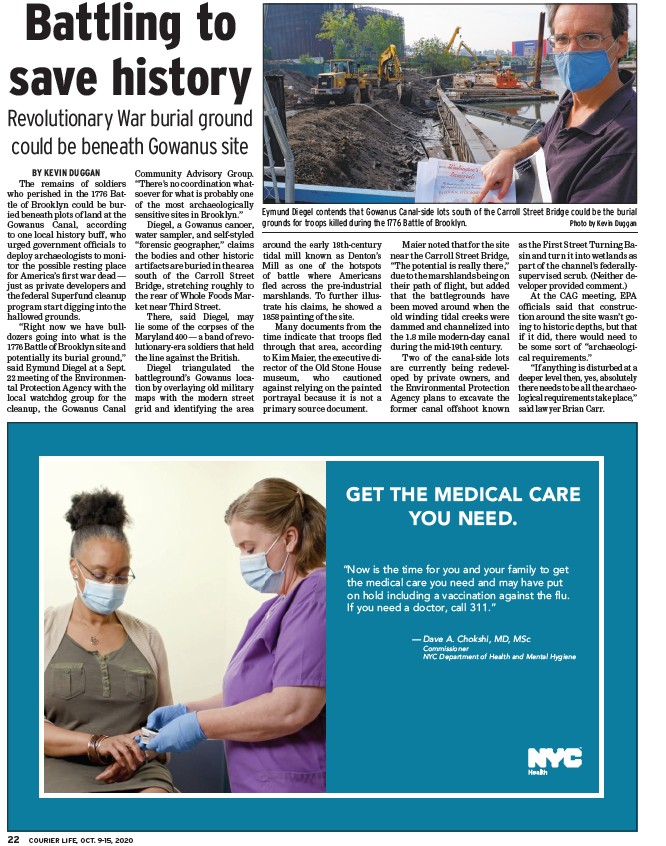
BY KEVIN DUGGAN
The remains of soldiers
who perished in the 1776 Battle
of Brooklyn could be buried
beneath plots of land at the
Gowanus Canal, according
to one local history buff, who
urged government offi cials to
deploy archaeologists to monitor
the possible resting place
for America’s fi rst war dead —
just as private developers and
the federal Superfund cleanup
program start digging into the
hallowed grounds.
“Right now we have bulldozers
going into what is the
1776 Battle of Brooklyn site and
potentially its burial ground,”
said Eymund Diegel at a Sept.
22 meeting of the Environmental
Protection Agency with the
local watchdog group for the
cleanup, the Gowanus Canal
COURIER L 22 IFE, OCT. 9-15, 2020
Community Advisory Group.
“There’s no coordination whatsoever
for what is probably one
of the most archaeologically
sensitive sites in Brooklyn.”
Diegel, a Gowanus canoer,
water sampler, and self-styled
“forensic geographer,” claims
the bodies and other historic
artifacts are buried in the area
south of the Carroll Street
Bridge, stretching roughly to
the rear of Whole Foods Market
near Third Street.
There, said Diegel, may
lie some of the corpses of the
Maryland 400 — a band of revolutionary
era soldiers that held
the line against the British.
Diegel triangulated the
battleground’s Gowanus location
by overlaying old military
maps with the modern street
grid and identifying the area
Eymund Diegel contends that Gowanus Canal-side lots south of the Carroll Street Bridge could be the burial
grounds for troops killed during the 1776 Battle of Brooklyn. Photo by Kevin Duggan
around the early 18th-century
tidal mill known as Denton’s
Mill as one of the hotspots
of battle where Americans
fl ed across the pre-industrial
marshlands. To further illustrate
his claims, he showed a
1858 painting of the site.
Many documents from the
time indicate that troops fl ed
through that area, according
to Kim Maier, the executive director
of the Old Stone House
museum, who cautioned
against relying on the painted
portrayal because it is not a
primary source document.
Maier noted that for the site
near the Carroll Street Bridge,
“The potential is really there,”
due to the marshlands being on
their path of fl ight, but added
that the battlegrounds have
been moved around when the
old winding tidal creeks were
dammed and channelized into
the 1.8 mile modern-day canal
during the mid-19th century.
Two of the canal-side lots
are currently being redeveloped
by private owners, and
the Environmental Protection
Agency plans to excavate the
former canal offshoot known
as the First Street Turning Basin
and turn it into wetlands as
part of the channel’s federallysupervised
scrub. (Neither developer
provided comment.)
At the CAG meeting, EPA
offi cials said that construction
around the site wasn’t going
to historic depths, but that
if it did, there would need to
be some sort of “archaeological
requirements.”
“If anything is disturbed at a
deeper level then, yes, absolutely
there needs to be all the archaeological
requirements take place,”
said lawyer Brian Carr.
Battling to
save history
Revolutionary War burial ground
could be beneath Gowanus site
GET THE MEDICAL CARE
YOU NEED.
Now is the time for you and your family to get
the medical care you need and may have put
Dave A. Chokshi, MD, MSc
Commissioner
NYC Department of Health and Mental Hygiene
—
“